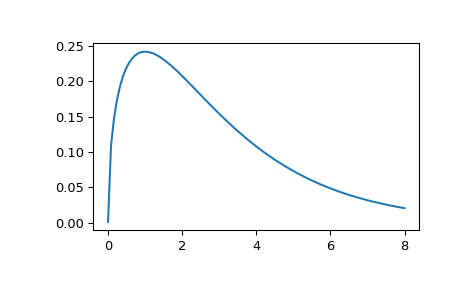scipy.stats.wishart#
- scipy.stats.wishart = <scipy.stats._multivariate.wishart_gen object>[source]#
A Wishart random variable.
The df keyword specifies the degrees of freedom. The scale keyword specifies the scale matrix, which must be symmetric and positive definite. In this context, the scale matrix is often interpreted in terms of a multivariate normal precision matrix (the inverse of the covariance matrix). These arguments must satisfy the relationship
df > scale.ndim - 1, but see notes on using the rvs method withdf < scale.ndim.- Parameters:
- dfint
Degrees of freedom, must be greater than or equal to dimension of the scale matrix
- scalearray_like
Symmetric positive definite scale matrix of the distribution
- seed{None, int, np.random.RandomState, np.random.Generator}, optional
Used for drawing random variates. If seed is None, the RandomState singleton is used. If seed is an int, a new
RandomStateinstance is used, seeded with seed. If seed is already aRandomStateorGeneratorinstance, then that object is used. Default is None.
- Raises:
- scipy.linalg.LinAlgError
If the scale matrix scale is not positive definite.
See also
Notes
The scale matrix scale must be a symmetric positive definite matrix. Singular matrices, including the symmetric positive semi-definite case, are not supported. Symmetry is not checked; only the lower triangular portion is used.
The Wishart distribution is often denoted
\[W_p(\nu, \Sigma)\]where \(\nu\) is the degrees of freedom and \(\Sigma\) is the \(p \times p\) scale matrix.
The probability density function for
wisharthas support over positive definite matrices \(S\); if \(S \sim W_p(\nu, \Sigma)\), then its PDF is given by:\[f(S) = \frac{|S|^{\frac{\nu - p - 1}{2}}}{2^{ \frac{\nu p}{2} } |\Sigma|^\frac{\nu}{2} \Gamma_p \left ( \frac{\nu}{2} \right )} \exp\left( -tr(\Sigma^{-1} S) / 2 \right)\]If \(S \sim W_p(\nu, \Sigma)\) (Wishart) then \(S^{-1} \sim W_p^{-1}(\nu, \Sigma^{-1})\) (inverse Wishart).
If the scale matrix is 1-dimensional and equal to one, then the Wishart distribution \(W_1(\nu, 1)\) collapses to the \(\chi^2(\nu)\) distribution.
The algorithm [2] implemented by the rvs method may produce numerically singular matrices with \(p - 1 < \nu < p\); the user may wish to check for this condition and generate replacement samples as necessary.
New in version 0.16.0.
References
[1]M.L. Eaton, “Multivariate Statistics: A Vector Space Approach”, Wiley, 1983.
[2]W.B. Smith and R.R. Hocking, “Algorithm AS 53: Wishart Variate Generator”, Applied Statistics, vol. 21, pp. 341-345, 1972.
Examples
>>> import numpy as np >>> import matplotlib.pyplot as plt >>> from scipy.stats import wishart, chi2 >>> x = np.linspace(1e-5, 8, 100) >>> w = wishart.pdf(x, df=3, scale=1); w[:5] array([ 0.00126156, 0.10892176, 0.14793434, 0.17400548, 0.1929669 ]) >>> c = chi2.pdf(x, 3); c[:5] array([ 0.00126156, 0.10892176, 0.14793434, 0.17400548, 0.1929669 ]) >>> plt.plot(x, w) >>> plt.show()

The input quantiles can be any shape of array, as long as the last axis labels the components.
Alternatively, the object may be called (as a function) to fix the degrees of freedom and scale parameters, returning a “frozen” Wishart random variable:
>>> rv = wishart(df=1, scale=1) >>> # Frozen object with the same methods but holding the given >>> # degrees of freedom and scale fixed.
Methods
pdf(x, df, scale)
Probability density function.
logpdf(x, df, scale)
Log of the probability density function.
rvs(df, scale, size=1, random_state=None)
Draw random samples from a Wishart distribution.
entropy()
Compute the differential entropy of the Wishart distribution.